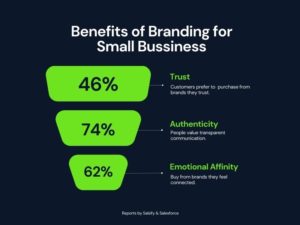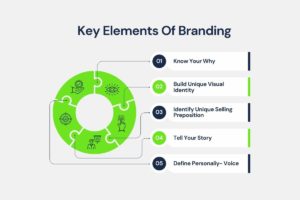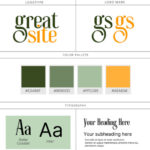CATEGORIES
#Branded #Education and Life Skills #EntrepreneurshipOverview:
- Explore the importance of branding for a small business in today’s competitive marketplace.
- Delve into the concept of brand and branding — exploring its fundamental elements and key aspects.
- Discover tips and strategies to begin branding for a small business with confidence and clarity.
Recently there has been a lot of buzz surrounding the terms “brand” and “branding“. However, before diving into what it is and how to start building your small business’s brand, let’s explore why it matters.
What Is the Significance of Branding for a Small Business?
Effective branding is vital in growing a business and establishing its reputation in a crowded marketplace. It helps you build your unique identity in customers’ minds, and build trustworthy, value-based relationships with them.

Recognition
First and foremost, branding helps you build a unique identity that makes it easy for customers to recognize you. For example, what comes to mind when you see the iconic red, blue, and white logo on store shelves? Pepsi, right? The easy recognition isn’t by accident; it is the result of consistent branding.
Reaching a Larger Market
Secondly, branding promotes business growth by building a reputation in the customer‘s mind. Research by Lucidpress indicates that consistent branding can increase revenue by 23 percent.
Building Trust and Customer Relationships
Effective branding is key to building trust and fostering strong emotional connections with customers. Customers are more likely to buy from brands they trust and have an emotional connection with. Despite its growing popularity and significance, there still needs to be clarity about what branding is and what is not. Therefore, in this blog you will get to know everything about branding as a beginner.
What Is Branding?
The term “branding” has been quite popular in the business and marketing world since the 1950s. It is defined as the process of creating a brand.
So, what exactly is a brand?
You might think it’s a logo, name, or color, right? While these are important parts of what constitutes a brand, there is more to it than that.
Well-known marketer Marty Neumeier defines a brand as ‘’a person’s gut feeling about a product, service, or organization.” He emphasizes that it is not what a company believes it is, but what people perceive it to be. It’s about the perception, value, and reputation that customers associate with your brand.

In today’s marketing landscape, branding is more about how customers feel about your brand than just visual elements. It encompasses customers’ overall experience with a brand, making it a comprehensive and continuous process.
Key Elements of Branding
Here are the several key elements you need to work on before building a brand for your small business.
Know Your Why ( Story, Mission, and Vision )
Before creating your brand, understand your business’ purpose and what drives it. What’s the story behind it? What problem are you solving, and what are your ultimate goals?
Cohesive and Unique Visual Brand Identity
As mentioned earlier, brand identity mainly consists of the visual elements of a brand such as logo, color, and typography. Choose and organize these elements cohesively. They must complement each other in digital and print formats.
Clear Brand Positioning
A well-defined brand positioning statement is crucial for good branding. It differentiates your business from your competitors by building a unique identity based on your unique selling proposition (USP). A strong statement gives customers a reason to choose you.
Brand Personality and Voice
Your brand’s personality and voice reflect how you present your business to customers. This includes the style, tone, and overall approach to content and interaction. Make sure your brand personality aligns with your business and customers and keep it consistent. Taking diversity and inclusion initiatives into account can make your brand stand out and make it more welcoming.

Kickstart Branding for a Small Business
Branding as a beginner may seem challenging, but the rewards are worth it. Let’s explore how you can get started with branding for a small business in 2024.
Research and Learn About Your Competitors and Customers
The first step in branding, especially for new businesses, is conducting market research. This research helps answer two key questions:
- Who are your biggest competitors?
- Who are your target customers?
Follow these simple steps to do market research and find your competitors:
Google Your Business: Google your business name and analyze the brands that appear on the first page. There are your direct and indirect competitors. Analyze their offerings, products’ key strengths, and weaknesses(e.g., quality, price, or packaging).
Analyze Competitor’s Branding Strategy: How are they marketing it? What channels do they use? How do they reach and influence the target customers? Do they offer special promotions?
Gather Industry Insight: Read industry news to understand trends and customer interest surrounding your product or service.
Identify Your Target Audience
Research Potential Customers: Who is your ideal customer? Analyze your competitors’ customers as a starting point.
Demographics, Interests, and Behavior: Understand your audience’s demographics (age, location, income), interests, and behavior. Research the social media platforms they use, communication style, beliefs, values, and lifestyle. This will help you effectively position and plan a comprehensive brand strategy for your small business from the start.
Discover Your Purpose
Mission: Clearly state your business’ purpose. What impact do you hope to achieve?
Vision: Describe your long-term goals. How will you solve the problems or improve the product/service you are working with?
Story: Share your inspiration for starting this business. Why this specific service or product? What’s the emotional connection? You can also share your journey if it aligns with your business goals.
A well-written mission, vision, and story are essential for branding and overall company performance. This is because everybody knows what they exist for, why, and where they hope to reach in the future.
Write Your Brand Positioning Statement
A Brand positioning statement clarifies your market position and differentiator. Begin with the following questions:
- What do you do?
- For whom?
- What makes you unique?
- Why should people purchase your product or service?
- Why should they choose you?
Identify Your Brand’s Personality and Voice
After writing the brand purpose, work on building the brand voice and personality.
Brand Personality: Brainstorm three adjectives that describe your brand as a person.
Brand Voice: Brand voice is similar to brand personality and is derived from it. How do you want to communicate with your customers (language, tone, and words you use)? Friendly, bold, serious, or humorous?
Write Your Tagline or Slogan
A unique and catchy tagline or slogan helps customers to remember you. Consider the following points while writing it:
- Ensure that it reflects your brand values and purpose.
- It should be unique and memorable.
- It should be clear and concise (avoid prepositions or commas).
Example: Nike’s “Just Do It” is short, catchy, and powerful.
Organize Your Brand Style Guide
Creating a brand style guide is essential for consistent branding. It’s a rulebook for everyone in your company on how to present your brand externally. It includes:
- Clear rules for logo design, color palette, text, and formatting styles.
- Description of brand’s personality, tone and voice, and guidelines for maintaining consistency.
- Clear instructions for consistent communication with colleagues, customers, and across marketing and general channels.
- Include visual examples to avoid confusion.

Choose a Name for Your Brand
A unique, memorable, and appealing brand name plays a major role in the marketing and growth of your business. Keep in mind these points while finalizing the brand name.
- It should reflect brand identity and values.
- Originality. Avoid copying.
- The simpler it is, the easier it will be to remember.
- Make sure it is available to use and has no legal restrictions.
Choosing the Right Colors and Font
Colors and fonts convey different moods and personalities (casual, playful, serious). For example, blue represents calmness (used in tech, finance, and health industries) while purple suggests creativity and inspiration. Choosing the colors that reflect your brand values is important especially when starting as a small business. It will give you an edge and help you stand out among the established and larger players in the market.
When choosing colors, it’s best to use two fonts: one for headings and one for body text. Consider how the font appears on different platforms, such as mobile, websites, and social platforms. Finally, choose a font that complements the logo shape.
Designing the Logo
A logo is a core element of your brand’s identity and branding. Here are some tips for you:
- Avoid using too many colors or elements in the logo.
- Ensure clarity and aesthetics across all platforms.
- Consider the different types and sizes of the logo.
For more in-depth tips on logo design, read ‘’How to Design a Logo: The Ultimate Guide and refer to’ “Beginners for Logo Design’’ from Canva.
Create Relevant Digital Channels
Once you understand your competitors and target customers, it’s time to create relevant digital channels to reach them and grow your business. Leverage your research to identify competitor channels. Which social media and digital channels are they using and which are performing well? Where are your ideal customers spending their time online?
Then, based on this information, align channels with your niche and goals. While a multi-channel social media presence can be beneficial, it is a one-size-fits-all strategy. Consider your niche. For example, a career-centered company or business might not need Instagram or TikTok. Analyze all factors and choose channels that align with your business goals and customer preferences.
Ensure Consistent Branding Across All Channels
Congratulations! You have completed all the essential steps for launching your business and building your brand. Consistent and cohesive branding establishes a strong brand identity.
Maintain consistency in:
Visual Representation: Ensure consistent use of your logo, colors, fonts, and design elements.
Customer Engagement and Communication: Develop a consistent voice and tone for all interactions with customers, regardless of the channel (in-store, online, social media)
Brand Values: Every interaction and communication should reflect your brand values and unique identity.
Conclusion:
Branding helps your small business succeed. If you are launching a business in 2024 or nurturing an existing venture, you must work on its branding. Remember, branding goes beyond visual identity—it’s an ongoing process of growth and refinement that strengthens your business over time.


